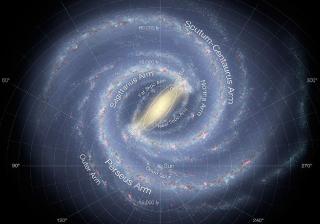Bibcode
Castro-Rodríguez, N.; López-Corredoira, M.
Referencia bibliográfica
Astronomy and Astrophysics, Volume 537, id.A31
Fecha de publicación:
1
2012
Revista
Número de citas
16
Número de citas referidas
13
Descripción
Aims: We present a determination of the intrinsic colors and ages
of galaxies at very high redshift, in particular old galaxies (OGs)
within extremely red objects (EROs). To date, the definition of EROs has
been restricted to objects with z < 2.5, however, here we consider
objects with the same properties but shifted to higher redshifts (z >
2.5). We therefore, refer to these objects as very high-redshift EROs
(Z-EROS, herein). Methods: We analyze 63 550 galaxies selected in
the XMM-LSS field. To obtain a reasonably sized sample of EROs, it is
essential to consider a very wide area surveys. We identify targets
within an area of 0.77 square degrees for which optical to mid-infrared
data are available from Subaru, UKIDSS, and Spitzer. We select Z-EROs
based on their colors, and then perform a selection of only OGs. One of
our novel innovations is to adapt the traditional method of EROs
selection based on the filters I and K, to higher redshifts. Using our
method, we identify 20 objects that satisfy the conditions required to
be Z-EROs/OGs at redshifts 2.5 ≤ z ≤ 3.8 within some conservative
constraints of errors in the photometric redshifts. For each of these
objects, we calculate the corresponding color at rest (B - V), and
estimate their average stellar mass and age by comparing this color with
a synthesis model. Results: Our selected galaxies have high
stellar masses ( 1011 M&sun;) and are older than 1
Gyr, hence their stellar populations were formed at z ≳ 4.7. After
including additional galaxies with z < 2.5 analyzed in a previous
paper, we find that the formation epoch depends significantly on the
observed redshift and stellar mass {partial t_form{partial t_obs}=
-0.9± 0.3 frac{partial t_form{partiallog
10M_*}=-4.8± 1.8 } Gyr. That is, the higher the
stellar mass, the lower the age of the Universe at which it was formed.
This result appears to conflict with Λ-CDM models that claim that
the most massive galaxies formed after lower mass.
Proyectos relacionados

Morfología y dinámica de la Vía Láctea
El Proyecto se estructura en dos partes, diferenciadas pero complementarias: morfología y dinámica. El estudio detallado de la morfología de la Vía Láctea pretende proveer una base de datos de distribución estelar en las regiones más alejadas y extintas de nuestra Galaxia, mediante el desarrollo de modelos semiempíricos a partir de la información
Martín
López Corredoira

Morfología y dinámica de la Vía Láctea
El Proyecto se estructura en dos partes, diferenciadas pero complementarias: morfología y dinámica. El estudio detallado de la morfología de la Vía Láctea pretende proveer una base de datos de distribución estelar en las regiones más alejadas y extintas de nuestra Galaxia, mediante el desarrollo de modelos semiempíricos a partir de la información
Martín
López Corredoira